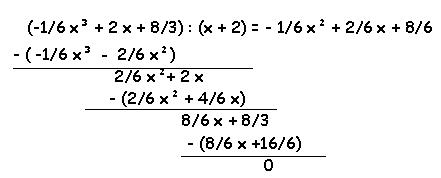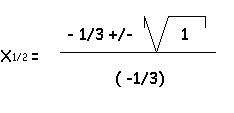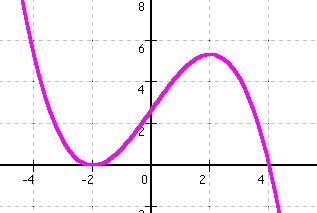Lösungen
1a)
f(x) = 7 * x³ + 3 * x + 5
f'(x) = 7 * 3 * x(3-1) + 3 * 1 * x(1-1) + 5 * 0 * x(0 -1)
f'(x) = 21 * x2 + 3
1b)
f(x) = x5 + 3 * x³ + 2 * x² - 8 * x
f'(x) = 1 * 5 * x(5-1) + 3 * 3 * x(3-1) + 2 * 2 * x(2-1) - 8 * 1 * x(1 -1)
f'(x) = 5 * x4 + 9 * x2 + 4 * x1 - 8
1c)
f(x) = - 0,5 * x4 + 2,5 * x³- 4 * x² + 1,5 * x - 3
f'(x) = - 0,5 * 4 * x(4-1) + 2,5 * 3 * x(3-1) - 4 * 2 * x(2-1) + 1,5 * 1 * x(1 -1) - 3 * 0 * x(0 -1)
f'(x) = - 2 * x3 + 7,5 * x2 - 8 * x1 + 1,5
f(x) = - 0,25 * ( x4 - 8 * x²- 9)
Nullstellen:
f(x) = 0
0 = - 0,25 * ( x4 - 8 * x²- 9)
0 = x4 - 8 * x²- 9
![]() Substitution:
x² = z
Substitution:
x² = z
0 = z²- 8 * z - 9
![]() Mitternachtsformel:
Mitternachtsformel:
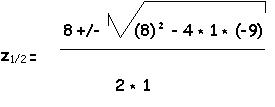
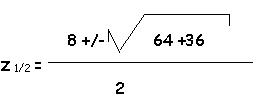
|
z1 = 9
|
|
|||||
|
z2 = - 1 |
|
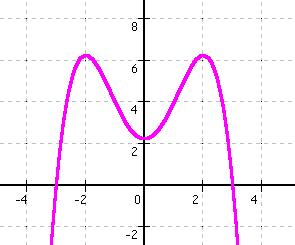
|
Extrempunkte:
![]() 1.
Ableitung !
1.
Ableitung !
f(x) = - 0,25 * ( x4 - 8 * x²- 9)
f'(x) = - 0,25 * (1 * 4 * x(4-1) - 8 * 2 * x(2-1) - 9 * 0 * x(0-1))
f'(x) = - 0,25 * (4 * x3 - 16 * x)
f'(x) = 0
0 = - 0,25 * (4 * x3 - 16 * x)
0 = 4 * x3 - 16 * x
0 =
x * (4 * x2 -
16) ![]() x1
= 0
x1
= 0
|
|
|
|
0 = 4
* x2 - 16
|
|
16 = 4 * x2
|
|
4 = x2
|
|
|
|
|
![]() Nachweis,
um welche Art des Extrempunktes es sich handelt - per Monotonietabelle:
Nachweis,
um welche Art des Extrempunktes es sich handelt - per Monotonietabelle:
f'(x) = - 0,25 * (4 * x3 - 16 * x)
|
|
x <
|
-2
|
< x <
|
0
|
< x <
|
2
|
< x
|
|
f'(x)
|
f'(-3) = - 0,25 * (4 * (-3)3 - 16 * (-3)) = 15 |
f'(x) = 0
|
f'(-1) = - 0,25 * (4 * (-1)3 - 16 * (-1)) = - 3 |
f'(x) = 0
|
f'(1) = - 0,25 * (4 * (1)3 - 16 * (1)) = 3 |
f'(x) = 0
|
f'(3) =
- 0,25 * (4 * (3)3 - 16 * (3)) = - 15 |
|
|
|
|
|
|
|
|
|
|
|
das heißt: der Wert von f' hat ein pos. Vor-zeichen (+) |
|
das heißt: der Wert von f' hat ein neg. Vor-zeichen (-) |
|
das heißt: der Wert von f' hat ein pos. Vor-zeichen (+) |
|
das heißt: der Wert von f' hat ein neg.Vor-zeichen (-) |
|
|
|
|
|
|
|
|
|
|
|
das heißt: dass die Funktion in diesem Bereich steigt |
|
das heißt: dass die Funktion in diesem Bereich fällt |
|
das heißt: dass die Funktion in diesem Bereich steigt |
|
das heißt: dass die Funktion in diesem Bereich fällt |
|
|
|
|
|
|
|
|
|
|
|
|
Daran kann man
erkennen, dass es sich um einen: HOP handelt. |
|
Daran kann man
erkennen, dass es sich um einen: TIP handelt. |
|
Daran kann man
erkennen, dass es sich um einen: HOP handelt. |
|
![]() Lage
der Extrempunkte:
Lage
der Extrempunkte:
f(x) = - 0,25 * (x4 - 8 * x²- 9)
![]() f(-2)
= - 0,25 * ( (-2)4 - 8 * (-2)²-
9) = 6,25
f(-2)
= - 0,25 * ( (-2)4 - 8 * (-2)²-
9) = 6,25 ![]() HOP
bei ( - 2/6,25 )
HOP
bei ( - 2/6,25 )
![]() f(0)
= - 0,25 * ((0)4 - 8 * (0)²-
9) = 2,25
f(0)
= - 0,25 * ((0)4 - 8 * (0)²-
9) = 2,25 ![]() TIP
bei ( 0/2,25 )
TIP
bei ( 0/2,25 )
![]() f(2)
= - 0,25 * ( (2)4 - 8 * (2)²-
9) = 6,25
f(2)
= - 0,25 * ( (2)4 - 8 * (2)²-
9) = 6,25 ![]() HOP
bei ( 2/6,25 )
HOP
bei ( 2/6,25 )
f(x) = 1/6 * ( - x³ + 12 * x + 16)
Nullstellen:
f(x) = 0
0 = 1/6 * ( - x³ + 12 * x + 16)
0 = - x³ + 12 * x + 16
![]() Ausprobieren
!
Ausprobieren
!
f(0) = 1/6
* ( - (0)³ + 12 * (0) + 16) = 1/6 * 16 = 8/3
! ![]() keine
Nullstelle !
keine
Nullstelle !
f(-2) = 1/6
* ( - (-2)³ + 12 * (-2) + 16) = 1/6 * ( 8 - 24
+ 16) = 1/6 * 0 = 0 ! ![]() eine
Nullstelle !
eine
Nullstelle !
![]() Polynomdivision
!
Polynomdivision
!
| [ 1/6 * (- x³ + 12 x + 16 )] |
= (- 1/6 x³ + 2 x + 8/3) |
|
0 = - 1/6 x² + 2/6 x+ 8/6
x1 = - 2 x2 = 4
|
Extrempunkte:
![]() 1.
Ableitung !
1.
Ableitung !
f(x) = 1/6 * ( - x³ + 12 * x + 16)
f'(x) = 1/6 * ( -1 * 3 * x(3-1) + 12 * 1 * x(1-1) + 16 * 0 * x(0-1))
f'(x) = 1/6 * (- 3 * x² + 12)
f'(x) = 0
0 = 1/6 * (- 3 * x² + 12)
0 = - 3 * x² + 12
- 12 = - 3 * x²
x² = 4
x1 = 2
x2 = - 2
![]() Nachweis,
um welche Art des Extrempunktes es sich handelt - per Monotonietabelle:
Nachweis,
um welche Art des Extrempunktes es sich handelt - per Monotonietabelle:
f'(x) = 1/6 * (- 3 * x² + 12)
|
|
x <
|
-2
|
< x <
|
2
|
< x
|
|
f'(x)
|
f'(-3) = 1/6 * (- 3 * (- 3)² + 12) = - 5/2 |
f'(x) = 0
|
f'(0) = 1/6 * (- 3 * (0)² + 12) = 2 |
f'(x) = 0
|
f'(3) =
1/6 * (- 3 * (3)² + 12) = - 5/2 |
|
|
|
|
|
|
|
|
|
das heißt: der Wert von f' hat ein neg. Vor-zeichen (-) |
|
das heißt: der Wert von f' hat ein pos. Vor-zeichen (+) |
|
das heißt: der Wert von f' hat ein neg.Vor-zeichen (-) |
|
|
|
|
|
|
|
|
|
das heißt: dass die Funktion in diesem Bereich fällt |
|
das heißt: dass die Funktion in diesem Bereich steigt |
|
das heißt: dass die Funktion in diesem Bereich fällt |
|
|
|
|
|
|
|
|
|
|
Daran kann man
erkennen, dass es sich um einen: TIP handelt. |
|
Daran kann man
erkennen, dass es sich um einen: HOP handelt. |
|
![]() Lage
der Extrempunkte:
Lage
der Extrempunkte:
f(x) = 1/6 * ( - x³ + 12 * x + 16)
![]() f(-2)
= 1/6 * ( -(- 2)³ + 12 * (- 2) + 16) = 0
f(-2)
= 1/6 * ( -(- 2)³ + 12 * (- 2) + 16) = 0
![]() TIP
bei ( - 2/0)
TIP
bei ( - 2/0)
![]() f(2)
= = 1/6 * ( -(2)³ + 12 * (2) + 16) = 16/3
f(2)
= = 1/6 * ( -(2)³ + 12 * (2) + 16) = 16/3
![]() HOP
bei ( 2/5,33 )
HOP
bei ( 2/5,33 )
f(x) = 0,5 * x³ - 0,5
Nullstellen:
f(x) = 0
0 = 0,5 * x³ - 0,5
0,5 = 0,5 * x³
x³ = 1 , also x = 1
|
|
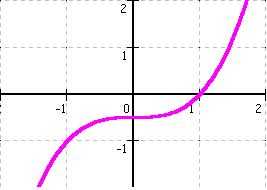 |
Extrempunkte:
![]() 1.
Ableitung !
1.
Ableitung !
f(x) = 0,5 * x³ - 0,5
f'(x) = 0,5 * 3 * x(3-1) - 0,5 * 0 * x(0-1)
f'(x) = 1,5 * x²
f'(x) = 0
0 = 1,5 * x²
0 = x²
x
= 0 doppelte
Nullstelle in f'![]() daraus
folgt: Terrassenpunkt!
daraus
folgt: Terrassenpunkt!
![]() Nachweis,
um welche Art von Punkt es sich handelt - per Monotonietabelle:
Nachweis,
um welche Art von Punkt es sich handelt - per Monotonietabelle:
|
|
x <
|
0
|
< x
|
|
f'(x)
|
f'(-1) = 1,5 * (-1)² = 1,5 |
f'(x) = 0
|
f'(1) = 1,5 * (1)² = 1,5 |
|
|
|
|
|
|
|
das heißt: der Wert von f' hat ein pos. Vor-zeichen (+) |
|
das heißt: der Wert von f' hat ein pos. Vor-zeichen (+) |
|
|
|
|
|
|
|
das heißt: dass die Funktion in diesem Bereich steigt |
|
das heißt: dass die Funktion in diesem Bereich weiter steigt |
|
|
|
|
|
|
|
|
Daran kann man
erkennen, dass es sich um einen: TEP handelt. |
|
![]() Lage
des Punktes:
Lage
des Punktes:
f(x) = 0,5 * x³ - 0,5
![]() f(0)
= 0,5 * (0)³ - 0,5 = - 0,5
f(0)
= 0,5 * (0)³ - 0,5 = - 0,5 ![]() TEP
bei ( 0/- 0,5)
TEP
bei ( 0/- 0,5)

